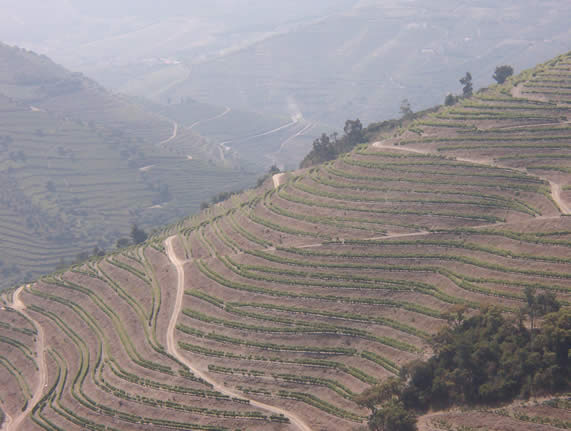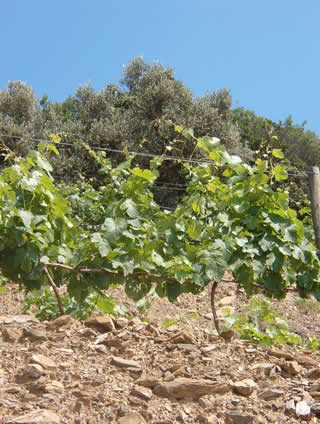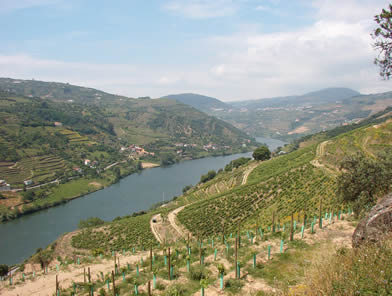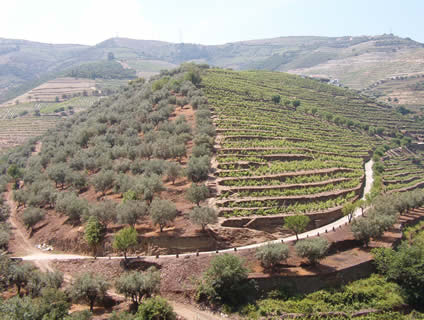
|
Spotlight
on Portugal's Douro region This is my second report on the new wave of Douro table
wines. The first was prompted by a
visit in June 2002. This visit, in
May 2004, was a chance to catch up on whatís been happening since,
so for context, it might be worth checking out the earlier article.
Iíll begin here with a quick recap of what it is that makes the
Douro such a special place for wine growing.
Second, we have the climate. The Douro is, again, unique in
Northern Portugal. Because it is protected by four mountain ranges (Serra
de Alvấo, Serra de Padrela and Serra de Bornes in the North;
Serra do Marấo in the west), it has hot, dry summers and very
cold winters. In the summer it is often 15 degrees warmer than Porto
on the coast. But it is more complicated than this. Within the Douro
there are quite marked differences between different vineyards sites
depending on the elevation (itís warmest down by the river), the
position along the river (the closer to Regua the cooler, generally)
and the exposure (not surprisingly, north-facing vineyards are
coolest). Third, itís the grape varieties. Loads of them. And with
the exception of Tinta Roriz (which is the same as Spainís
Tempranillo), they are uniquely Portuguese. Old vineyards will
typically be mixed plantings of dozen of varieties, but more recently
varieties have been planted in their own blocks, a move likely to
result in higher quality because of even ripeness levels.
Fifth, itís the untapped potential. To understand this we
need a bit of historical context. Wine grapes have been grown in the
Douro since Roman times, but for a long time the vines were grown in
the gaps of the stone terraces, with the flat parts reserved for
agriculture. The Douro boomed when Port was discovered in the late
17th century, and demand for Portuguese wine in England soared as the
English were at was with the French. The fortuitous discovery was that
brandy addition during fermentation stabilized the wine brilliantly,
leaving it with some sweetness, too, and the capacity to age. It was a
hit. In the mid 18th century this success led to overproduction
resulted, triggering a price collapse. The result was that the Marques
de Pombal initiated the worldís first system of control of origin
and regional classification, differentiating among good and bad
cultivation sites and demarcating the extent of the Douro wine region.
The next big change to sweet the Douro was the shift from Quinta
production (wines produced and marketed by individual winegrowers) to
shippers based in Vila Nova de Gaia (over the river from Porto).
Effectively, what happened is that Port became the worldís first
branded wine. In the 1850s James Forester mapped the Douro, counting
some 79 Quintas. By the 1950s, these were no longer significant, and
instead they had been replaced by 81 This changed with a new law in 1986 that opened up the
field, allowing Douro producers to export their products
independently. There were a few restrictions retained, which tried to
stack things in favour of the established shippers who already had
Quintas in the Douro, but there have since been a growing band of
Quintas who have made and marketed their own Port wines. This new
dynamism has undoubtedly led many to consider making table wines, too.
This brings us to the present. The development of premium
Douro wines has been catalogued well elsewhere
on this site. The revolution continues, and there are now at least
half a dozen wines made in the Douro each vintage that could genuinely
be considered world class; many more are almost there. The progress
made in less than a decade has been staggering. The big glitch was the
2002 vintage, which was close to disastrous in many parts of the Douro.
Only a few producers genuinely managed to harvest before the rains,
which caused such problems. Fortunately 2003 was a very good, if hot
year, and while 2004 looked to be problematic, a late burst of fine
weather looks set to seal this vintage as a good one too. Anyway, on to the winesÖ
|



 Port lodges in Vila Nova (a
number which fell by more than half ins subsequent decades through
mergers and acquisitions). Shippers worked differently from Quintas:
they bought wines from growers in the Douro, shipped them down to
their lodges, and blended them into their brands. A law was even
passed making this maturing and storing of Port wines in lodges at
Vila Nova mandatory. This effectively ruled out newcomers, and
prevented Douro estates from marketing their own wines.
Port lodges in Vila Nova (a
number which fell by more than half ins subsequent decades through
mergers and acquisitions). Shippers worked differently from Quintas:
they bought wines from growers in the Douro, shipped them down to
their lodges, and blended them into their brands. A law was even
passed making this maturing and storing of Port wines in lodges at
Vila Nova mandatory. This effectively ruled out newcomers, and
prevented Douro estates from marketing their own wines.